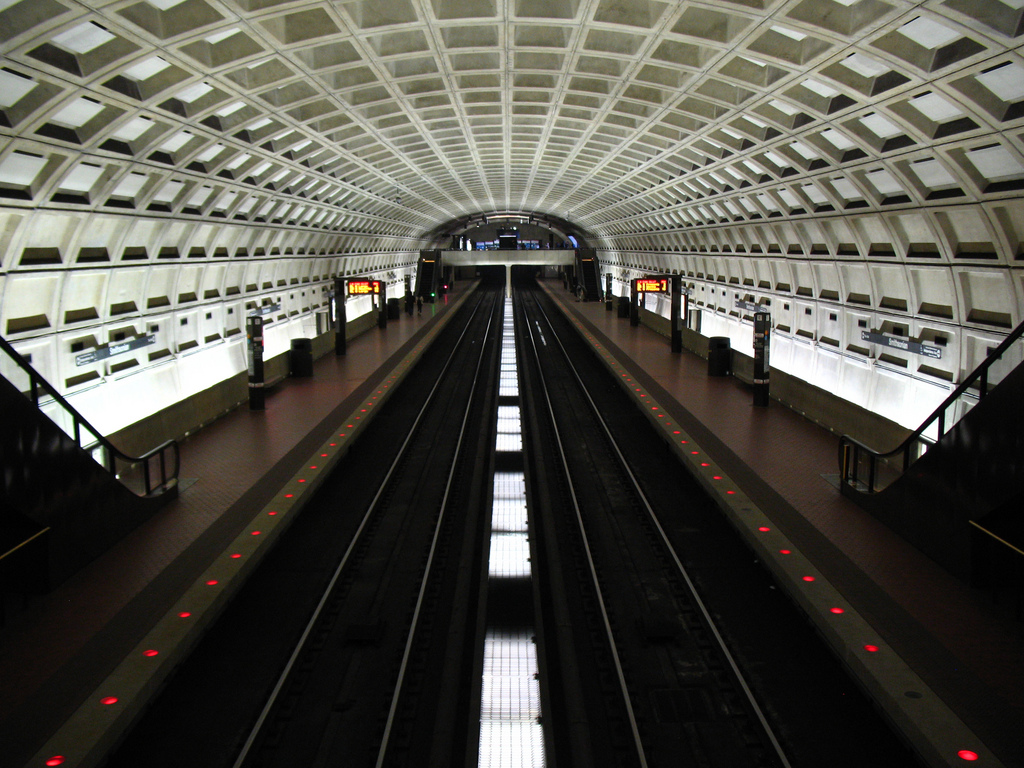As a presidential candidate, Donald Trump’s commitment to infrastructure improvement was one of the marquee proposals that fortified his populist credentials and distinguished him from other Republicans. After his electoral victory it posed a challenge to Democrats, who were forced to determine whether or not they would work with the new administration. Now President Trump has made a show of proposing to spend new money. The projects to be initiated and the methods by which they would be financed are unspecified, reflecting a vagueness that has become a pattern in White House plans. The proposal was rolled out during what the White House branded as #InfrastructureWeek. Unsurprisingly, it does not amount to much. But how the president got to this point and the sort of nothing that his infrastructure proposal offers is worth unwinding.
Trump’s infrastructure plan is not really a plan. It is a propaganda exercise.
The White House announcement for #InfrastructureWeek trots out all the statistics on the decay of America’s roads, bridges, airports, railways, inland waterways, pipelines, and ports. For instance: “The impact of the United States’ infrastructure investment gap per household is $3,100 in lost income, according to analysis from The American Society of Civil Engineers.” Trump could not resist a cheap shot at the Obama administration for failing to dedicate more of its stimulus money to public investment, a criticism that misunderstands the purpose of stimulus—to get more money spent quickly. The “spend-out” rate for big infrastructure projects is usually too slow for timely stimulus. Such projects are commendable for providing valuable public facilities, but they are ill-suited to combatting recessions. In the latest instance of presidential hypocrisy, the new administration is reported to want its own projects to get going within ninety days. This too precludes big new endeavors that require years of preparation—feasibility studies, engineering work, financial transactions—before any shovels touch dirt.
So how big is the breadbox? The White House commits to “$200 billion in his budget as part of a $1 trillion investment plan to rebuild infrastructure” over ten years. But what about the other $800 billion? The answer provided is “a mixture of loans and grants.”
The Lure of Deregulation
It is telling that in the government’s sales pitches, the first action item is not new money, but reducing regulation. Projects may require permits from the federal government, and that takes time. The White House claims that ten years is typical, but they promise to reduce it to two. Of course, they failed to note that their predecessors have already facilitated faster approval of new projects. Permitting is aimed at satisfying environmental requirements, among other things. Easier permitting could entail a sacrifice of environmental interests.
Trump’s vehicle for expediting permitting is a new executive order. It reads: “It is the policy of the executive branch to streamline and expedite, in a manner consistent with law, environmental reviews and approvals for all infrastructure projects.” On its face, that would seem to mean everything and nothing. We will expedite, but we will be bound by the same laws that consumed so much time in the past. Like much in this administration’s policy, it is impossible to foresee the outcome of this order on its face.
Not only could $200 billion not turn into $1 trillion, the actual impact could be less than $200 billion itself.
Vice President Pence blamed lengthy permit requirements on bureaucrats. As a former bureaucrat myself, I can confirm that this is delusional. Bureaucrats do what the law and their executive leaders tell them to do. It is like blaming the Internal Revenue Service for the complexity of tax law written in the Congress.
It is true that permitting can be inordinately time-consuming. What would be sacrificed under a less stringent regime remains to be seen. What should go without saying is that even with eased permitting requirements, nothing is going to get done without money.
Leverage
Now let us take up the mystery of turning $200 billion into $1 trillion. The government’s game here is spending money in a way that encourages others to chip in. A variety of devices are conceivable.
In the case of state and local governments, funds could be provided via matching grants. Under, let’s say, a 30 percent match, you spend $100, we reimburse you $30. So a dollar of spending only costs you 70 cents of your own revenues (taxes, for the most part). If I want to maximize the effort on your end, I make the match “open-ended.” You spend as much of your money as you can at a 30 percent discount.
Another method is a loan guarantee. You can sell bonds to private parties who will accept a lower interest rate because the government guarantees repayment. Without special rules for dealing with loans, this shows up as a zero-cost item in budget accounting, as long as the borrower keeps up their payments. Loan guarantees are also an option for the private sector. The government could contract with a private engineering company to build something. The company could be authorized to sell bonds (borrow money, in other words) that have a federal guarantee. As above, this is a subsidy to the company, corporate welfare if you like. The pot can be sweetened further if interest on the loans is made tax-exempt, as is currently the case for qualified bonds sold by state and local governments.
The reality is that public investment projects routinely involve the private sector.
One problem with this plan is that when a private sector firm borrows from the private sector, whoever operates the facility must also be able to collect fees for its use, such as tolls for a highway or bridge. But not all big, worthwhile projects lend themselves to user fees. Fee-based privatized projects are inherently limited in scope. Another issue is that people don’t like tolls. Still another is that user fees that make for efficient use of a facility a) need not be fair (should we charge residents of Flint, MI, for the cost of providing them with a system that delivers potable water?), and b) need not be set correctly. The fee that maximizes the revenue of a facility operator need not equal the fee that makes for efficient use of or fair access to a facility.
If the government sells $100 billion worth of bonds under normal circumstances, especially with the advantage of today’s rock-bottom interest rates, it is no further in debt than if it sells $100 billion in tax-advantaged bonds. The difference is that over subsequent periods, the tax advantages of the latter bonds under privatization schemes cost the government, meaning you and me, more than if it sold standard securities to finance a new project. Interest rates are higher, the tax revenue loss is greater, and the Federal Treasury has taken on greater risk.
The grand illusion stems from the privatization bonds being transacted “off-budget.” At the outset, there is likely no impact on the federal deficit, but with a federal guarantee, the impact on the government’s balance sheet properly accounted for is greater, due to the revenue impact, the interest costs, and the greater risk of default on the bonds that are secured by some kind of user fee scheme.
The biggest problem with leverage is political. Those you want to leverage have their own preferences on how much money they want to commit to your desired projects. State and local governments prefer money without a match, since they can then put up as much of their own money as they would like. For the same reason, a grant with as few conditions as possible is always preferred to a loan that you have to repay. The private sector likes subsidized loans, but they still have to be interested in doing the project. It still has to meet some threshold of profitability, one that is reduced but not eliminated by a loan guarantee.
In all cases, the question is whether funds will be provided in a way that incentivizes the recipient to do more than they would have otherwise. After all, infrastructure investment goes on all the time. The question is whether new money or subsidies of another type from the federal government can generate activity beyond what would have taken place anyway. This depends on assistance that is successfully designed in the face of political influence that seeks to eliminate any constraints on the recipient. Not only could $200 billion not turn into $1 trillion, but the actual impact could be less than $200 billion itself.
Watch What We Do, Not What We Say
The headline numbers of $200 billion and $1 trillion should be discounted by pending cuts in the federal budget for existing funding of infrastructure. The gory details are elaborated here by the Economic Policy Institute. Gauging the behavior of state and local governments in response to a new program is usually difficult, but this is a simple accounting exercise.
For instance, in the Trump budget, the Department of Transportation, which funds the bulk of federal support for public investment, is looking at a reduction of 13 percent over the next ten years. For surface transportation alone (highways and rail), the Congressional Budget Office estimates a reduction of $139 billion. There are also cuts in other types of infrastructure. That takes a big bite out of Trump’s headline numbers, whatever they turn out to be. Senate Minority Leader Chuck Schumer said the total cuts to public investment in the Trump budget total $206 billion over ten years. Administration actions have already killed some projects that were in motion. In fact, Trump may be killing old projects faster than his administration is approving new ones.
The president calls the Democrats in Congress obstructionists, but their actual power to block legislation is limited.
I take exception to the Economic Policy Institute’s emphasis on “pay-fors.” Pay-for is shorthand for the gratuitous requirement that any spending proposal must be accompanied by an equivalent tax increase. The claim is that a proposal is only as real as its financing. Not quite. Progressive proposals need not be burdened by financing components, for two reasons. The first is political: it is a mistake to burden one’s own proposals for worthwhile investments with unappealing financing mechanisms. This is no way to compete with the right, who observe no such inhibitions. The second is economic. Most proposals are small in the context of the federal revenue system. For the 2017 fiscal year, for instance, federal revenue was projected to come in at $3,460 billion. Trump’s infrastructure money averages $20 billion a year. In that context, do we really want to doodle with pay-fors?
The proper deficit level does not depend on the addition of specific projects or a raft of new projects to federal spending, but on employment conditions. Once you have added up all your spending plans and your anticipated revenue, you can decide how to address any gap. Introducing the ‘pay-for’ question into a discussion of the merits of a new project, or a basket of projects, is a distraction.
The Privatization Bogeyman
A recent report tells us that some consultants are advising advocates of the Trump plan not to burden their proposal with the term privatization. Instead they suggest “asset reallocation.” This results in some confusion about the very nature of public investment.
The reality is that public investment projects routinely involve the private sector. More projects under any new regime would entail private participation. Federal, state, and local governments do not operate their own engineering and construction firms; they contract out to them. State and local governments often avail themselves of private sector financing by selling bonds. In fact, most public investment is undertaken by state and local governments, and they should be committing more resources to it themselves.
One example is the proposed privatization of air traffic control. Both supporters and critics of the move like to use the term privatization, but for contrasting reasons. Supporters want to persuade the public that this move will bring improved efficiency to air travel. Critics, on the other hand, believe that the term has connotations that are more negative than positive. The reality is that the new entity will not be a private, profit-making corporation. Instead it will be a quasi-public organization for which private sector participation remains to be determined.
The success of a privatization deal depends on the sort of contract that is struck, as Hunter Blair elaborates. Ethically challenged dealmakers are likely to make deals against the public interest. This obviously has great salience under the current administration. The players matter more than the mechanisms that might be employed to launch projects. At this point the arrangements have yet to be open for review, though the grounds for pessimism are clear.
The bottom line is that the scare of privatization tends to be overstated on the liberal side of the spectrum and its glories overstated on the right. It really depends on the case in question. Privatization of, say, food stamps or Medicaid promises to be a horror. For public investment, economic debacles are foreseeable but not inevitable.
Right now, we have no reason to believe that the Trump infrastructure plan will facilitate more rapid approval of projects without objectionable environmental and other fallouts, or that it will increase resources committed to public investment. In fact it is not really a plan. To date, it is mostly a propaganda exercise.
As with health care and tax reform, the White House issues the substantive equivalent of a press release, signs a hollow executive order, and passes the baton to Congress, which has yet to enact any legislation of note. The president calls the Democrats in Congress obstructionists, but their actual power to block legislation is limited; they are in the minority in both houses. The failure here embraces both the Republican caucuses on Capitol Hill and the White House.
America’s ascendance to greatness remains out of view.








